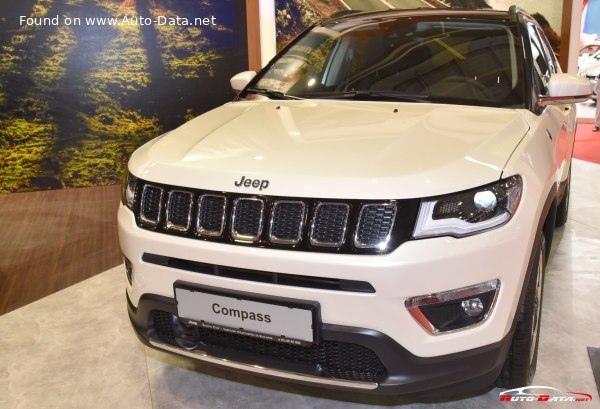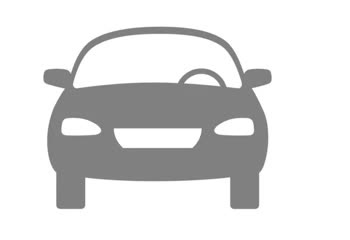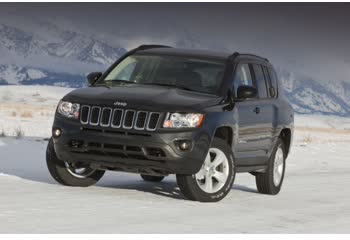Everything you need to know about specifications and performance - Jeep Compass 2017 - 2.0 Multijet (140 Hp) 4x4 Automatic

Overview:
What is the engine capacity of a Jeep Compass 2017?
The engine capacity of the Jeep Compass 2017 is 1956.
Jeep Compass 2017 How many horsepower?
The engine power of the Jeep Compass 2017 is 140 Hp @ 4000 rpm..
What is the Jeep Compass 2017 engine?
Jeep Compass 2017 engine is EBS, EBT. (Click to see other cars using the same engine)
How much gasoline does a Jeep Compass 2017 consume?
The Jeep Compass 2017 consumes 5.7 liters of gasoline per 100 km
General:
Brand: Jeep
Model: Compass
Generation: Compass II (MP)
Modification (Engine): 2.0 Multijet (140 Hp) 4x4 Automatic
Start of production: July, 2017
End of production: August, 2018
Powertrain Architecture: Internal Combustion Engine
Body type: Sports Utility Vehicle (SUV)
Seats: 5
Doors: 5
Engine:
Engine systems: Start & Stop System
Power: 140 hp @ 4000 rpm.
Power per litre: 71.6 hp/l
Torque: 350 nm @ 1750 rpm.
Engine Model/Code: EBS, EBT
Engine displacement: 1956
Number of cylinders: 4
Engine configuration: Inline
Number of valves per cylinder: 4
Fuel injection system: Diesel Commonrail
Engine aspiration: Turbocharger, Intercooler
Valvetrain: DOHC
Engine oil capacity: 4.2 l
Coolant: 6.5 l
Engine layout: Front, Transverse
Cylinder Bore: 83 mm
Piston Stroke: 90.4 mm
Compression ratio: 16.5:1
Performance:
Fuel Type: Diesel
Fuel consumption (economy) - urban: 6.6 l/100 km
Fuel consumption (economy) - extra urban: 5.1 l/100 km
Fuel consumption (economy) - combined (NEDC): 5.7 l/100 km
Fuel consumption (economy) - urban (NEDC): 6.6 l/100 km
Fuel consumption (economy) - extra urban (NEDC): 5.1 l/100 km
Fuel consumption (economy) - combined: 5.7 l/100 km
Emission standard: Euro 6
Acceleration 0 - 100 km/h: 9.9 sec
Acceleration 0 - 62 mph: 9.9 sec
Maximum speed: 190 km/h
Weight-to-power ratio: 11 kg/Hp, 90.9 Hp/tonne
Weight-to-torque ratio: 4.4 kg/Nm, 227.3 Nm/tonne
Acceleration 0 - 60 mph: 9.4 sec
Space:
Kerb Weight (kg): 1540-1741
Max. weight (kg): 2132
Max. roof load: 68 kg
Max load (kg): 391-592
Trunk (boot) space - maximum: 1251 l
Trunk (boot) space - minimum: 438 l
Permitted trailer load with brakes (12%): 1500 kg
Fuel tank capacity: 60 l
Permitted trailer load without brakes: 525 kg
Permitted towbar download: 75 kg
dimensions:
Ramp-over (brakeover) angle: 22.9°
Wading depth: 406 mm
Length: 4394 mm
Width: 1819 mm
Height: 1647 mm
wheelbase: 2636 mm
Front track: 1550 mm
Rear (Back) track: 1550 mm
Ride height (ground clearance): 215 mm
Minimum turning circle (turning diameter): 11.07 m
Approach angle: 16.8°
Departure angle: 31.7°
Powertrain, Suspension and Brakes:
Drivetrain Architecture: The Internal combustion Engine (ICE) drives the front wheels permanently, and the rear wheels are driven through an electrically or mechanically operated clutch if necessary.
Drive wheel: All wheel drive (4x4)
Number of gears and type of gearbox: 9 gears, automatic transmission
Front brakes: Ventilated discs
Rear brakes: Disc
Assisting systems: ABS (Anti-lock braking system)
Steering type: Steering rack and pinion
Power steering: Electric Steering
Tires size: 225/60 R17; 225/55 R18; 235/45 R19
Wheel rims size: 7J x 17; 7J x 18; 7.5J x 19
Front suspension: Independent, type McPherson with coil Spring and anti-roll bar
Rear suspension: Independent coil spring, Transverse stabilizer
See also

Last generation.
Its production began in 2022 until Now

Other generation.
Its production began in 2011 until 2016

Write a comment